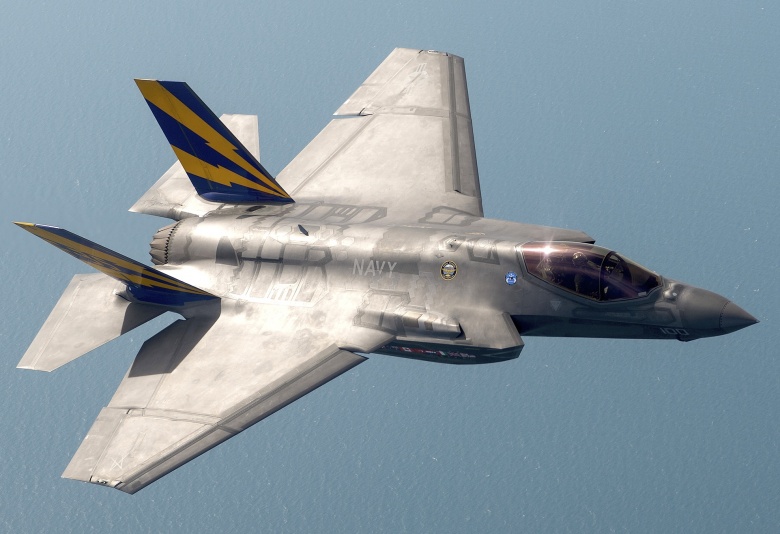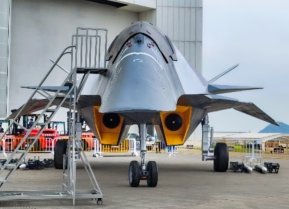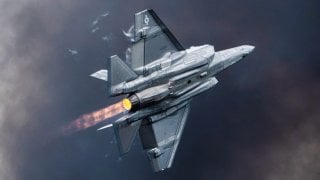The Houthis Are In 'Panic Mode': The F-35C Has Gone Into Battle
The F-35C Lightning II, designed for carrier operations, saw its first combat use in November 2024. U.S. Marine Corps squadron VMFA 314, operating aboard the USS Abraham Lincoln (CVN-72), conducted strikes on Houthi weapons facilities in Yemen.
What You Need to Know: The F-35C Lightning II, designed for carrier operations, saw its first combat use in November 2024. U.S. Marine Corps squadron VMFA 314, operating aboard the USS Abraham Lincoln (CVN-72), conducted strikes on Houthi weapons facilities in Yemen.

-This marked the debut of the carrier-capable F-35C, adding to the combat record of the F-35 program. With foldable wings, a larger wingspan, reinforced landing gear, and enhanced control surfaces, the F-35C is tailored for naval operations.
-Capable of carrying over 18,000 lbs of ordnance, it brings significant versatility and lethality to carrier strike groups.
F-35C Lightning II Makes Combat Debut in Strikes Against Houthi Targets
In spite of all of the F-35 Lightning II’s controversies over her cost overruns and reliability issues, the fifth-generation stealth fighter program (the latest brainchild of Lockheed Martin’s legendary “Skunk Works” division) continues to soldier on.
The Israeli Air Force was the first entity to use the F-35 in combat, giving the F-35I Adir (“Mighty One”) variant her proverbial “baptism of fire” against Hezbollah targets in Lebanon in May 2018. Three months later, the U.S. Marine Corps (USMC) followed suit with the F-35B’s first “blooding” with a strike against a Taliban target in Afghanistan. In April 2019, it was the F-35A’s turn, with the U.S. Air Force employing a pair of them to conduct an air strike against Islamic State targets at Wadi Ashai, Iraq, in support of Combined Joint Task Force—Operation Inherent Resolve.
Fast forward to the present, and the F-35C variant of the Lightning II has finally arrived rather belatedly to the combat initiation party, but as the saying goes, “Better late than never!”

The Basic Details
Just like with the F-35B, it was the good ol’ Teufelhunden (“devil dogs”), i.e., the U.S. Marines, who were the first to use the F-35C in combat. The details come to us courtesy of a November 18, 2024, press release from the Carrier Strike Group 3 Public Affairs Office titled “U.S. Marine Squadron Conduct First Combat Strikes Using F-35C Platform Against Houthi Targets in Yemen”:
“U.S. Marine Corps F-35C Lightning II aircraft, assigned to Marine Fighter Attack Squadron (VMFA) 314, conducted the first F-35C combat air strikes for the platform, Nov. 9-10 … VMFA 314, assigned to Carrier Air Wing (CVW) 9 aboard the Nimitz-class aircraft carrier USS Abraham Lincoln (CVN 72), conducted multiple strikes on Houthi weapons storage facilities within Houthi-controlled territories in Yemen. The facilities housed conventional weapons, including anti-ship missiles. The Iranian-backed Houthis used these weapons to target U.S. and international military and civilian vessels navigating international waters in the Red Sea and Gulf of Aden …‘The F-35C demonstrated its warfighting advantage by transiting contested airspace and striking targets in the heart of Houthi territory over multiple days,’ said U.S. Marine Lt. Col. Jeffrey ‘Wiki’ Davis, commanding officer of VMFA 314. ‘My Marines are honored to be first to fight with the F-35C.’”
VMFA 314—nicknamed the “Black Knights” and home-based at Marine Corps Air Station (MCAS) Miramar, California, is indeed the only deployed F-35C squadron in the USMC. MCAS Miramar, of course, used to be Naval Air Station (NAS) Miramar, immortalized in the original “Top Gun“ movie in 1986.
Ordnance Involved?
The report didn’t specify the exact weaponry employed in these strikes, but we do know that the F-35C can carry more than 5,000 lbs of internal weapons, or more than 18,000 lbs of combined internal and external weapons. Among the ground-attack weapons in the warbird’s arsenal are:
· AGM-88G AARGM-ER HARM (High-speed Anti-Radiation Missile) Block 4
· AGM-154 JSOW (Joint Standoff Attack Weapon)
· GBU-39 Small Diameter Bomb (SDB)
· Paveway laser-guided bomb (LGB)
· AGM-158 Joint Air-to-Surface Standoff Missile (AGM-158 JASSM)
· AGM-179 Joint Air-to-Ground Missile (JAGM)
· Stand-in Attack Weapon (SiAW)

Unique Features of the F-35C
Okay, so what distinguishes the F-35C from the other variants of the Lightning II?
Well, being designed and built explicitly for Navy carrier operations, she has foldable wingtip sections, larger control surfaces for improved low-speed control, stronger landing gear for the stresses of carrier arrested landings, a twin-wheel nose gear, and a stronger tailhook for use with carrier arrestor cables.
She also had the largest wingspan—43 feet (13.1 meters) vs. 35 feet (10.6 meters) for the A and B variants—which allows for decreased landing speed while increasing both range and payload.
Christian D. Orr, Defense Expert
Christian D. Orr is a Senior Defense Editor for National Security Journal (NSJ). He is a former Air Force Security Forces officer, Federal law enforcement officer, and private military contractor (with assignments worked in Iraq, the United Arab Emirates, Kosovo, Japan, Germany, and the Pentagon). Chris holds a B.A. in International Relations from the University of Southern California (USC) and an M.A. in Intelligence Studies (concentration in Terrorism Studies) from American Military University (AMU). He has also been published in The Daily Torch , The Journal of Intelligence and Cyber Security, and Simple Flying. Last but not least, he is a Companion of the Order of the Naval Order of the United States (NOUS).
Image Credit: Creative Commons.


